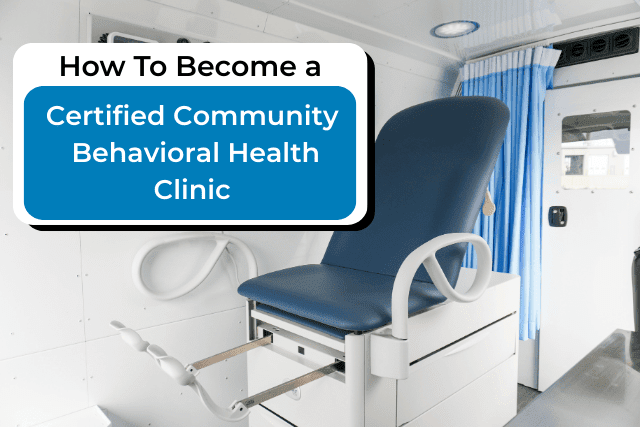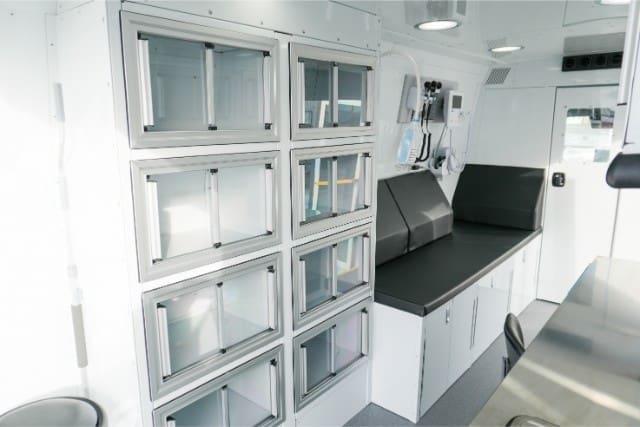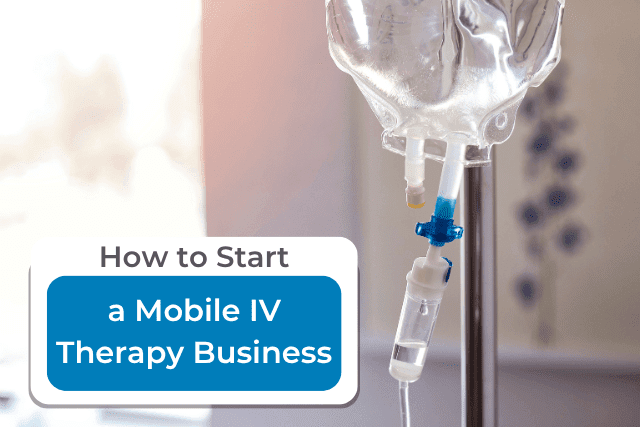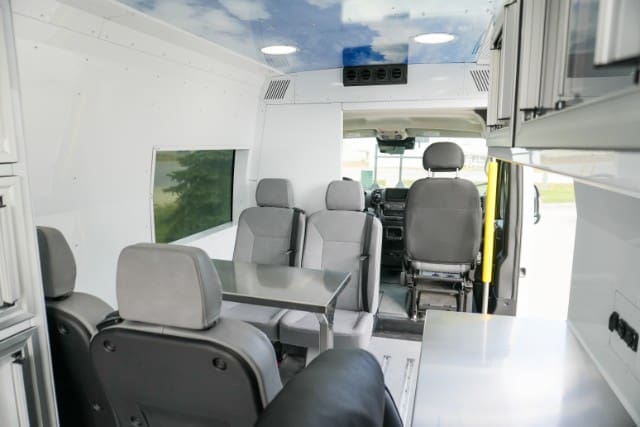How to become a certified community behavioral health clinic is a question many nonprofit and healthcare leaders are asking, and for good reason. Did you know that over 150 million people in the U.S. live in mental health professional shortage areas? That’s nearly half the country.
Maybe your organization experiences the pressure of some of these gaps every day:
- People are waiting months for help
- Rural areas are without clinics
- Existing programs are overwhelmed
You want to do more, but the path to becoming a certified community behavioral health clinic feels complicated. The risk of mistakes feels high, and time isn’t on your side.
Becoming a SAMHSA-certified community behavioral health clinic can change that. It can open funding, expand services, and bring care to communities that have waited long enough.
Our team at AVAN Mobility understands these challenges. For more than 10 years, we’ve worked with non-profits, tribal health organizations, and healthcare teams like yours and Pacific Clinics all over the U.S.. We build mobile units designed to fit each program’s needs, and we stay involved well beyond delivery. Our goal is simple: help you reduce barriers and save lives.
In this guide, you’ll learn:
- What a CCBHC is and why it matters
- The steps to become certified
- How mobile units can support your program
What is a certified community behavioral health clinic?
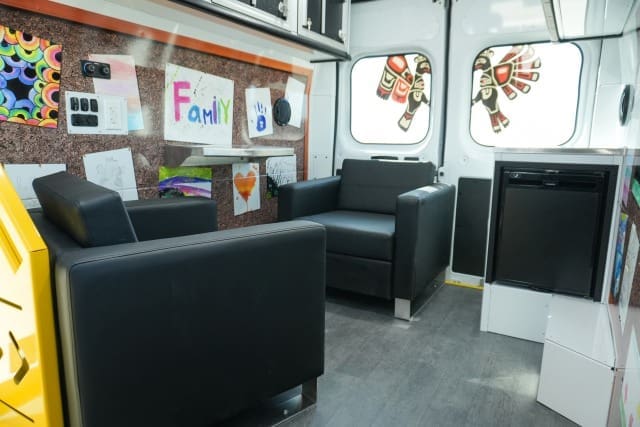
A certified community behavioral health clinic (CCBHC) is a special type of clinic that provides mental health and addiction care to anyone who needs it. These clinics are backed by federal guidelines and must follow strict rules to make sure care is high-quality, quick, and easy to access.
CCBHCs were created to help fix the broken parts of the mental health system. In places where care is hard to find, people can’t afford it, or services are scattered all over town, CCBHCs bring everything together.
What does a CCBHC have to offer?
CCBHCs must provide at least nine core services, either at their clinic or through trusted partners:
- Crisis care: Help available 24/7, including mobile crisis teams
- Screening and assessments: Quick checks to spot mental health or substance use concerns
- Treatment planning: Custom care plans that involve the person and their family
- Mental health and addiction treatment: Outpatient services for all ages
- Primary care checks: Blood pressure, diabetes, and other basic health checks
- Case management: Help with housing, legal issues, and other life needs
- Psychiatric rehab: Skills training for people to live and work better
- Peer and family support: Support from people who’ve been through it too
- Care for veterans: Focused support for those who’ve served
Why are CCBHCs so important?
- Open to all: No one gets turned away because of income, insurance, or where they live
- Faster care: Most people are seen in days, not weeks. While the national average wait time is still around 48 days, CCBHCs are designed to beat that, especially with mobile healthcare teams meeting people where they are.
- Better funding: As of January 2025, 14 new states plus Washington, D.C. are building CCBHC programs through Medicaid planning grants or SAMHSA expansion grants. Many of these will join the demonstration program by 2026, unlocking stable funding streams.
- Local focus: With over 500 CCBHCs in 46 states, D.C., and Puerto Rico, clinics are serving nearly 3 million people, and many are adding mobile outreach vans to extend services directly into rural and underserved communities. In Connecticut, for example, lawmakers are working to expand the CCBHC model statewide.
There are now over 500 CCBHCs in 46 states, Washington, D.C., and Puerto Rico, helping nearly 3 million people get care they may not have received otherwise. That’s a big deal.
How are CCBHCs different?
A CCBHC isn’t your typical clinic. It brings together everything from therapy to addiction services, peer support, and medical checks, all under one roof. Unlike other community clinics, CCBHCs follow a model built to remove gaps in care and make support easier to get.
How to become a certified community behavioral health clinic in 10 steps
Becoming a certified community behavioral health clinic is big work, and you want clear direction from the start. We’ll walk you through each step so you don’t miss anything essential. This is the official roadmap vetted by SAMHSA and state certification programs. Let’s get into step one.
1. Assess eligibility and community need
To start your journey toward becoming a certified community behavioral health clinic, first determine if your organization qualifies:
- You must be a nonprofit, tribal organization, or public clinic, or partner with one if you’re private.
- Conduct a community needs assessment. Use SAMHSA’s toolkit to identify gaps in local behavioral health services.
- Some states also require a letter of interest or a pre-registration step before you apply.
This first step is about mindfully matching your mission with community needs. If your area has limited mental health services or no crisis team, that gap is exactly what the CCBHC model addresses. A clear assessment helps build a case for certification.
2. Secure funding and payment pathways
Before starting the certification process, you need a clear plan for how your clinic will operate financially, including any mobile behavioral health programs you plan to run. Certification can open many doors, but it also comes with responsibilities and costs.
- SAMHSA grants: You can apply for SAMHSA expansion grants. New clinics can look into Planning, Development & Implementation grants, while established clinics may go for Improvement & Advancement grants. These help with planning, hiring, and launching services.
- Medicaid PPS support: Many states participate in the Section 223 Medicaid Demonstration, which gives certified clinics a set payment per patient per day for both brick-and-mortar and mobile-delivered services.
- State-run programs: Several states, including the 14 awarded 2025 planning grants, are designing their own payment models for CCBHCs. These models often reimburse for mobile crisis and outreach visits the same way as in-clinic visits.
Example: Connecticut used a federal planning grant to build a statewide payment model for CCBHCs. This made Medicaid payments more predictable and helped more clinics get started.
A good funding plan is one of the strongest foundations you can set. It makes certification work for your clinic, instead of vice versa.
Tip: Include the operating costs for your mobile program in your cost modeling so your PPS rate or state payments reflect the full scope of your services.
3. Understand SAMHSA certification criteria
In March 2024, SAMHSA updated its certification standards, adding more focus on mobile crisis outreach and stabilization services as part of 24/7 crisis care.
Before moving forward, you’ll need to get familiar with the SAMHSA CCBHC criteria. These are the rules every certified community behavioral health clinic must follow. They cover everything from the services you offer to how you track outcomes.
Here’s what the criteria focus on:
- Scope of services: Clinics must deliver or arrange all nine core services, including 24/7 crisis care, outpatient treatment, primary care screenings, and peer support. Mobile crisis response can now be a primary method for meeting crisis care requirements.
- Access to care: CCBHCs have to provide timely appointments, often within days, and offer services regardless of a person’s ability to pay. Mobile programs can help CCBHCs meet “timely access” standards by reducing delays for people far from clinic locations.
- Care coordination: To coordinate patient care, you’ll need strong partnerships with hospitals, primary care, law enforcement, schools, and social services.
- Quality reporting: Clinics must collect data and track outcomes to show how well services are working.
Example: In states like Missouri and Oklahoma, early CCBHC adopters had to strengthen partnerships with local ERs and justice systems to meet coordination standards.
Understanding these criteria early helps you prepare your team, close service gaps, and plan for changes before you apply.
4. Build your care network
A certified community behavioral health clinic can’t do everything alone. Part of the certification process is proving that you have a strong care network. This means having agreements with other providers and services to make sure clients get the full range of support they need.
Here’s what that usually looks like:
- Local hospitals and ERs: So patients in crisis can move smoothly between emergency care and ongoing treatment
- Primary care providers: To handle physical health needs like checkups, labs, and chronic disease care
- Schools and youth programs: For early intervention and youth mental health support
- Housing services: To connect clients with stable living arrangements if needed
- Law enforcement and justice systems: To provide support for people coming out of jail or at risk of arrest due to behavioral health issues
Many states require MOUs (Memoranda of Understanding) as proof of these relationships.
Example: In Oklahoma, CCBHCs built partnerships with rural hospitals so crisis patients didn’t sit in ERs for days waiting for help. These partnerships became part of their certification approval.
Building your care network early shows that you’re ready to meet CCBHC standards and gives your clients faster, more coordinated help.
5. Create your plan for certification
Now it’s time to put everything into a clear plan for becoming a certified community behavioral health clinic. This plan keeps your team on track and shows that you’re serious about meeting the requirements.
Your plan should cover:
- Services offered: List how you’ll provide all nine core services, including crisis care, outpatient treatment, and case management
- Staffing needs: Identify which positions you have, which you need to hire, and how you’ll meet staffing standards
- Partnerships: Outline your care network and any agreements with outside providers
- Facilities and equipment: Make sure your clinic space and resources meet accessibility and safety requirements
- Compliance and reporting: Plan how you’ll track quality measures and report data to your state or SAMHSA
Example: In Texas, clinics applying for CCBHC certification created a step-by-step action plan with timelines. This helped them stay organized and hit deadlines without scrambling at the last minute.
A solid plan with a detailed timeline gives your team a clear roadmap for running a CCBHC that serves your community well.
6. Staff your clinic with the right team
Having the right staff in place is a core part of becoming a certified community behavioral health clinic. SAMHSA requires a team that matches your community’s needs and meets official standards. More CCBHCs are designing teams that include dedicated mobile crisis and outreach staff.
Here’s what that means:
- Leadership roles: A clinic needs a CEO (or project director) and a medical director. The medical director can be a psychiatrist or another qualified prescriber. They don’t have to be full-time, but must be available in person sometimes.
- Clinical staff: This includes licensed counselors, social workers, psychologists, and trauma-informed specialists with training for working in mobile settings (privacy, safety, and field-based care).
- Peer and family support: People with lived experience help clients feel understood and supported. These roles are required for certification.
- Support staff: Depending on your services, nurses, case managers, health workers who can rotate between the fixed clinic and the mobile unit may be needed.
Staff need training on:
- Trauma-informed care
- Suicide and overdose prevention
- Cultural competence
- Mobile safety
- Outreach engagement
- Crisis intervention in community settings
- Family-centered and recovery-focused approaches
Training must happen at hire and at least once a year. You’ll need to keep records of who’s trained and how often.
- Plan around real-world realities: If your area has a shortage of mental health providers, it’s okay to contract or share staff across multiple sites
- Allow part-time or telehealth coverage: These options work as long as the clinic covers each role properly.
Planning to run a mobile medical unit? If your plan includes a mobile medical unit, your staffing plan needs to explain how staff will work in mobile settings. That could mean rotating team members or dedicated mobile staff. Just make sure their roles meet the same standards as your main site.
7. Develop your compliance and reporting systems
Once your staffing plan is set, the next step in becoming a certified community behavioral health clinic is building strong systems for compliance and reporting. These are essential for certification and for maintaining your status over time.
Here’s what you’ll need:
- Policies and procedures: Written documents that show how you meet each certification standard, from service delivery to patient rights
- Data tracking systems: Tools to collect information on patient outcomes, wait times, crisis response, and other quality measures
- Quality improvement plan: A process for reviewing your data, spotting gaps, and making changes
- Privacy protections: Systems to follow HIPAA and 42 CFR Part 2 rules for patient information
Example: Many clinics use electronic health record (EHR) systems that integrate data reporting. This makes it easier to meet both state and SAMHSA requirements without creating extra paperwork for staff.
A strong compliance system helps you pass certification and keeps your clinic running smoothly in the long term. Many states require quarterly reports, so build your systems for frequent updates.
8. Prepare for the site review and readiness check
Before you become a certified community behavioral health clinic, your state (or SAMHSA, depending on the path) will want to see your clinic in action. This usually includes a site visit or readiness review to make sure everything matches your application. Some states call this a mock certification review, and passing it moves you to final approval.
Here’s what to focus on:
- Facility walk-through: Make sure your building, or mobile unit, if you use one, is accessible, safe, and ready for patients. This includes ADA compliance, private spaces for care, and clear safety protocols.
- Documentation review: Inspectors will want to see proof of your policies, staff credentials, training logs, and agreements with partner organizations.
- Operational systems: Demonstrate how you track appointments, coordinate care, and handle emergencies. If you use a mobile medical unit, be ready to explain how it operates in alignment with CCBHC standards.
- Mock service scenarios: Some states test your team’s readiness by walking through real-world situations like crisis calls or care coordination between agencies.
Example: In New York, clinics going through readiness checks prepared a binder (physical or digital) with all their policies, contracts, and training documents in one place. This made the review faster and showed the team was organized.
A smooth readiness check sets the tone for your certification. It shows your clinic is fully capable of providing the services outlined in your plan.
9. Submit final paperwork and get approvals
After your readiness check, the next step to becoming a certified community behavioral health clinic is sending in your final paperwork. This is where you pull everything together.
What you’ll need to send:
- Application: Make sure it matches what was reviewed during the site check
- Proof of staff and policies: Copies of licenses, training records, agreements with partner agencies, and clinic rules
- Quality reports: Show how you track patient care, outcomes, and protect privacy
- Budget and funding details: Include where your funding comes from and how your payment model works
Your state or SAMHSA will look over everything to confirm your clinic meets the rules. They may ask you to make changes before approval if something is missing or unclear.
Example: In Minnesota, some clinics were asked to update their staffing plans after sending in paperwork. Adjustments like this are normal and part of the process.
Sending clear, well-organized paperwork can help speed up approval and show your clinic is ready to start serving the community.
10. Maintain your certification
Getting certified as a community behavioral health clinic is a big milestone, but the work doesn’t stop there. To keep your certification, you’ll need to show you’re meeting the standards year after year.
Here’s what ongoing compliance looks like:
- Regular reporting: Send updates to your state or SAMHSA on services, patient outcomes, and quality improvements
- Annual training: Keep staff training current on trauma-informed care, suicide prevention, cultural competence, and other required topics
- Quality reviews: Review your data to find areas for improvement and make updates when needed
- Partnership check-ins: Maintain active agreements with hospitals, primary care, housing services, and other partners
- Site visits: Be ready for periodic inspections or reviews to confirm your clinic is still meeting standards
Example: In Oklahoma, clinics that stayed on top of training and quality reporting found recertification much smoother because they weren’t scrambling to catch up.
Maintaining certification is about keeping your services strong so your community continues to benefit from everything your clinic offers.
How can mobile medical units support your certified community behavioral health program?
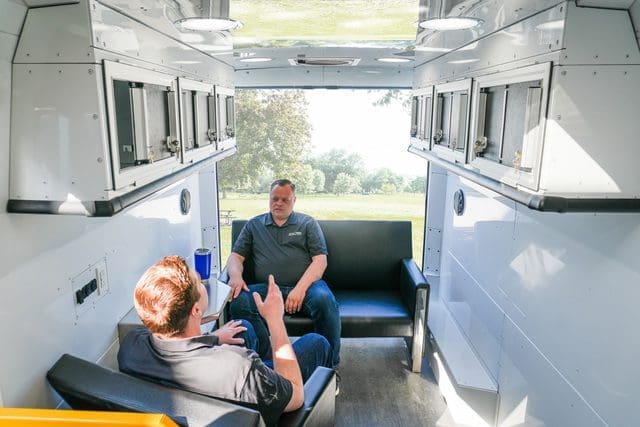
One of the biggest hurdles for certified community behavioral health clinics is simple: Getting care to the people who need it most. The 2025 National Crisis Guidelines now recognize mobile crisis outreach and stabilization as essential parts of a complete behavioral health system.
That’s where a Mobile Counseling Van or Mobile Outreach Van can help you help your clients while meeting your 24/7 crisis care requirement. Instead of waiting for clients to come to you, you bring the help to them.
Think about the people you serve. Some live miles from the nearest clinic. Others don’t have reliable transportation. Some might avoid walking into a clinic because of stigma. A Mobile Counseling Van breaks through those barriers.
Here’s what it can do for your program:
- Reach more people: Show up right in neighborhoods where care is hard to find
- Protect privacy: Offer a safe, comfortable space for one-on-one conversations
- Respond fast: Be there after community crises or high-stress events
- Ease pressure: Provide extra support while clients wait for clinic appointments
These vans are built to meet the same standards as your main site, from safety to accessibility. You can staff them with rotating team members or create a dedicated mobile crew.
Bottom line? A Mobile Counseling Van makes your program more flexible, more visible, and more connected to the people you want to help.
Ready to become a certified community behavioral health clinic?
You came to this article because becoming a certified community behavioral health clinic felt like a maze. The regulations, the paperwork, and the uncertainty about where to start were holding you back.
Now you have the tools to move forward:
- You know the 10 steps to certification
- You’ve seen how a Mobile Counseling Van can support your program
- You understand how to keep your clinic compliant for the long run
At AVAN Mobility, we’ve worked with teams like the Community Clinic of Southwest Missouri in rural, urban, and tribal communities to design mobile units that work in the real world. Our process is built around listening first, then creating solutions that fit your program, not forcing you into a one-size-fits-all model.
We’ve seen firsthand the difference a well-planned mobile program can make. It’s all about helping you save lives, grow your reach, and strengthen your community. If you have questions, click the button below to talk to a mobility expert.
If you’re not ready to talk yet, here are a few articles to guide you forward:
- Top 10 tips on fundraising for a Mobile Clinic Van: Explore funding strategies to turn your CCBHC mobile program into reality.
- Buying a mobile medical van—your process with AVAN Mobility: Learn what the buying process looks like so you can confidently plan your next steps.
